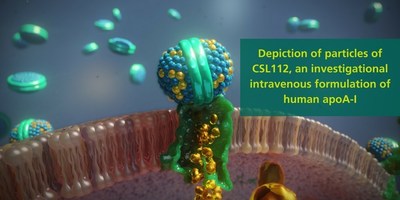CSL Behring Presents Positive Results from the CSL112 AEGIS-I Phase IIb Trial
NEW ORLEANS, Nov. 15, 2016 /PRNewswire/ -- CSL Behring today announced positive results from AEGIS-I, a Phase 2b safety and proof of mechanism clinical study of CSL112, a novel apolipoprotein A-I (apoA-I) infusion therapy. CSL112 is being developed to reduce the high incidence of early recurrent cardiovascular events that occur in the weeks to months following a heart attack, most commonly due to additional rupture of vulnerable atherosclerotic plaque, which is an accumulation of fatty material on the innermost layer of the artery wall and which can obstruct blood flow.

The AEGIS-I study met its co-primary safety endpoints, showing that CSL112 does not cause significant changes in liver or kidney function and demonstrating that it is well-tolerated when administered in the acute myocardial infarction (MI) setting. The study also provided confirmation of CSL112's unique mechanism of action, cholesterol efflux enhancement, as demonstrated by an immediate, up to four-fold increase in cholesterol efflux capacity, compared to baseline. It is believed that by producing an immediate and profound enhancement of cholesterol efflux capacity, which is the removal of cholesterol from the plaque in the arteries, CSL112 may rapidly stabilize additional lesions at risk of rupture thereby reducing the high rate of recurrent events following a heart attack.
Results from AEGIS-I were presented today at the American Heart Association Scientific Sessions in New Orleans, LA and published online in Circulation.
"CSL112 may represent an exciting new approach to treating high-risk patients following an acute MI," said Michael Gibson, M.D., Ph.D., Professor of Medicine at Harvard Medical School and co-lead investigator of the AEGIS-I study. "By directly targeting and stabilizing plaque very soon after the initial event, CSL112 has the potential to change our current treatment paradigm and improve outcomes for millions of heart attack survivors around the globe."
UNMET NEED
In the US alone, approximately 750,000 heart attacks occur every year.1 For those patients who survive, the risk is not over. Approximately one in five will experience a recurrent cardiovascular event within one year; most of those events occur very early - up to half within the first month, and recurrent events are associated with worse clinical outcomes.2,3,4 By rapidly removing cholesterol from plaque following a heart attack, CSL112 may help to stabilize dangerous lesions in the arteries that could otherwise erupt and cause another cardiovascular event. [Download PDF to learn more about CSL112 and Acute Myocardial Infarction (MI)]
"We are highly encouraged by the impressive results of this clinical study demonstrating that CSL112 significantly increases cholesterol efflux capacity in patients who have suffered a heart attack, with no significant changes to liver or kidney function," said Larry Deckelbaum, Global Clinical Therapeutic Area Head, Cardiovascular at CSL Behring. "The AEGIS-I results support continued planning for Phase 3 to determine whether increasing cholesterol efflux capacity with CSL112 translates into improved cardiovascular outcomes."
MECHANISM OF ACTION
Data from AEGIS-I confirm that CSL112 immediately increases cholesterol efflux capacity approximately four-fold compared to baseline. "Cholesterol efflux" is the natural removal of cholesterol from the plaque by apoA-I (the major protein component of High-Density Lipoprotein "HDL"), which then transports cholesterol to the liver to be eliminated from the body. By enhancing cholesterol efflux capacity, CSL112 may potentially lead to a reduction in the high rate of early recurrent events following a heart attack. This is particularly important for patients who have had a heart attack, in whom cholesterol efflux capacity is impaired.5
THE PATH FORWARD
The potential benefit of CSL112 to reduce early recurrent cardiovascular events after a heart attack would need to be assessed in a large Phase 3, morbidity and mortality trial. The AEGIS-I results support continued planning for Phase 3. As well, further data are being gathered in an ongoing Phase 2 study in MI patients with moderate renal impairment.
ABOUT AEGIS-I STUDY DESIGN
AEGIS-I is a multicenter, randomized, double-blind, placebo-controlled, dose-ranging, Phase 2b safety and proof of mechanism trial that enrolled 1,258 acute MI patients. Patients were stratified by renal function and randomized to receive four weekly infusions of either CSL112 2g/dose, CSL112 6g/dose or placebo.
ABOUT CSL112
CSL112 is a novel formulation of plasma-derived apoA-I, the primary functional component of HDL. It is reconstituted to form HDL particles suitable for intravenous infusion. Studies have shown that infusion of CSL112 rapidly enhances cholesterol efflux capacity, a process by which cholesterol is removed from plaque and transported to the liver for elimination from the body. CSL112 may offer a new approach for rapidly stabilizing atherosclerotic plaque lesions and is being developed for reduction in the risk of early cardiovascular events in acute myocardial infarction patients.
ABOUT CSL BEHRING
CSL Behring, in collaboration with its parent company, CSL Limited, is developing CSL112. CSL Behring is a global biotherapeutics leader which is driven by its promise to save lives. Focused on serving patients' needs by using the latest technologies, we develop and deliver innovative therapies that are used to treat coagulation disorders, primary immune deficiencies, hereditary angioedema, inherited respiratory disease, and neurological disorders. The parent company, CSL Limited (ASX: CSL), headquartered in Melbourne, Australia, employs more than 16,000 people with operations in more than 30 countries. For more information visit www.cslbehring.com and follow us on www.Twitter.com/CSLBehring.
1 American Heart Association. Heart Disease and Stroke Statistics2016 Update. Circulation. 2015;132:000-000. DOI: 10.1161/CIR.0000000000000350
2 Jernberg T, et al. Cardiovascular risk in post-myocardial infarction patients: nationwide real world data demonstrate the importance of a long-term perspective. Eur Heart J. 2015;36:1163-1170.
3 Kohli P, et al. Reduction in First and Recurrent Cardiovascular Events With Ticagrelor Compared With Clopidogrel in the PLATO Study. Circulation. 2013;127:673-680.
4 Shotan A, et al. Comparison of Outcome of Recurrent Versus First ST-Segment Elevation Myocardial Infarction (from National Israel Surveys 1998 to 2006). Am J Cardiol. 2011;107:1730-1737.
5 Hafiane A, et al. High-Density Lipoprotein Mediated Cellular Cholesterol Efflux in Acute Coronary Syndromes. Am J Cardiol. 2014;113:249-255.
Photo - http://photos.prnewswire.com/prnh/20161115/439652
To view the original version on PR Newswire, visit:http://www.prnewswire.com/news-releases/csl-behring-presents-positive-results-from-the-csl112-aegis-i-phase-2b-trial-300363434.html
SOURCE CSL Behring

